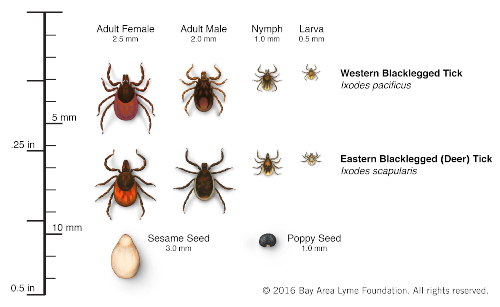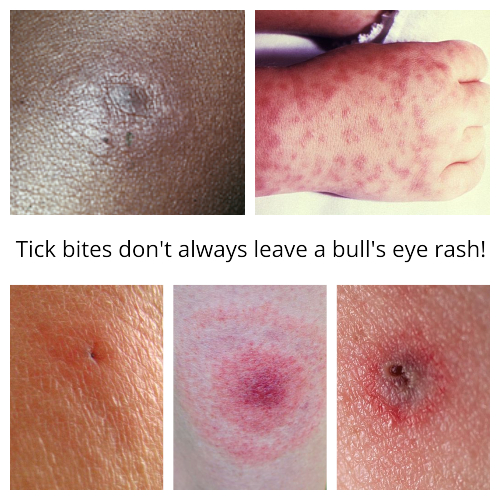Preventing Tick Bites & Lyme Disease
Want to spend time outdoors without the fear of you
& your loved ones being exposed to Lyme Disease?
If you're like me, you enjoy lying in the grass reading books, traipsing through meadows, communing with wild trees, and napping in the warm autumn sun. I've been known to misplace my children when they're reading in the bushes in a park or sitting up in a tree. These past few summers and falls I've become ever more vigilant about ticks, and myself and my children being exposed to Lyme Disease.
There's no question that nature connection is necessary for us biologically, psychologically and emotionally. But with the spread of Lyme-bearing ticks throughout southern Canada, we all need to learn how to prevent and manage ticks.
I will share some facts and some solutions below...

My concern snuck up on me, really.
Years ago I saw a film that featured a father suffering with Lyme Disease. An Anarres customer, herself a nurse, had to beg doctors to provide her with antibiotic treatment to prevent infection. A student at Anarres told me about her daughter being bitten by a deer tick and what she went through to spare her child from infection. A customer with Lyme Disease and Multiple Chemical Sensitivities joined us for a series of workshops.
I watched the documentary The Punk Singer https://www.youtube.com/watch?v=fwrXC5OXqgc and learned that Riot GRRRl heroine Kathleen Hanna had been ill with Lyme. I was distressed to learn that Julia Butterfly Hill, a passionate environmental activist whom I admire greatly has been suffering with Lyme. And an herbalist whose tea blends I buy. And then the emails started coming from concerned parents, teachers and lovers of the outdoors. A beloved Anarres apprentice has struggled with Lyme and co infections for many years. On top of this, she contracted COVID in February of 2020 and is still recovering from "long COVID". Inspired to learn how to help, in April 2019 I participated in the Healing Lyme and Coinfections Practitioner Training Intensive with Clinical Herbalist and Lyme specialist Julie McIntyre . While I was a good student, once out of the classroom, I determined that I did not have the experience to do justice to any client struggling with Lyme and Co-Infections.
I continue to learn, but in the meantime, I think that sharing prevention is the most practical way to help! Luckily, I have learned a few solid pieces of advice through research, listening to people affected and talking with medical professionals. I will briefly share some of what I've learned with you so that you can feel confident to enjoy the outdoors during the tick seasons, April to October.
WHAT IS LYME DISEASE AND HOW IS IT SPREAD?
Lyme Disease is a bacterial infection spread by three species of ticks that can be carriers: dog, deer and black-legged ticks. In North America, the bacterium is Borrelia burgdorferi. In areas where Lyme is common, half of all ticks are carriers. Lyme disease is spread by these ticks when they burrow into the skin and stay there for their blood meal. You may hear that to transmit Lyme disease, a tick needs to be attached for at least 36 hours, but the other infections can be transmitted in a few hours or even a few minutes. Fortunately, Lyme disease is not contagious between people. The chance of catching Lyme disease from an individual tick ranges from roughly zero to 50 percent. The risk of contracting Lyme disease from a tick bite depends on three factors: the tick species, where the tick came from, and how long it was biting you.

WHY DOES PREVENTING TICK BITES MATTER?
Lyme Disease, Rocky Mountain spotted fever and its other co-infections cause very serious illness. Lyme disease can cause symptoms of rheumatoid arthritis and debilitating problems in the skin, joints, heart, and nervous system, even for years after initial infection.
WHAT ARE TICKS?
Ticks are mites, eight legged blood sucking relatives of spiders. Black legged, deer and dog ticks transmit the spiral-shaped bacteria and co-infections of Lyme Disease.
HOW DO YOU KNOW IF YOU HAVE A TICK ON OR IN YOU?
Hopefully, you can see it, or the entry point or bump on your skin when you inspect yourself. Seek medical attention IMMEDIATELY if you've been bitten.
Flu-like symptoms generally begin even before a rash develops: fever, chills, muscle aches, joint pain, headache, swollen lymph nodes near the bite, spasms, numbness or tingling, facial paralysis and fatigue. Seek medical attention IMMEDIATELY if you haven't already.
If you've been bitten and infected, a rash may appear 3-30 days afterwards. According to the CDC, approximately 70–80 percent of people with Lyme disease develop the classic bull's-eye rash within 30 days of infection, but others say the classic bull's eye rash is less common. Seek medical attention IMMEDIATELY if you haven't already.

So how can we prevent getting bitten by a tick?
REPEL
When you get ready to go outside to enjoy grass or trees, apply a tick repellant to your clothing, bags and exposed skin and hair. DEET works, but specific essential oils have been shown to be as good or better than DEET at repelling ticks. Consider Anarres' Feisty Floral Outdoor Perfume, our new evidence-based Tick-ed Off Repellant and Bite Antiseptic Outdoor Perfume My (Don't) Bite Me Kit contains ingredients and recipes for repelling ticks.
Wear long sleeves with cuffs at the wrists, and tuck your pants into your socks. Some people duct tape at the cuffs, but you can use rubber bands if your cuffs aren't cutting it!
REVEAL
Wear light-coloured clothes and a hat so a tick will be easier to see if one lands on you.
Check for ticks regularly while you are out, and give your body a thorough inspection each morning before getting dressed, each evening getting undressed for bed, and after coming in from the outdoors. Tricky places to look are the scalp, under the arms, behind and in the ears, in a belly button, and in the butt and genital areas.
Inspecting morning, after coming in and at night will give you more opportunities to find a tick before it can infect you.
Dry the clothing you wore and any bags in a hot dryer (or keep these outside of your home or vehicle) to kill any ticks that came home with you.
REMOVE
It’s very important to remove a tick immediately, and without squeezing the potential bacteria-laden innards into you.
We offer a really affordable tick removal tools:
Tick: Removal Kit, Plastic Pocket Set of 2 ONLY $2 http://www.anarreshealth.ca/product/tick-removal-kit-plastic-pocket-set-2
Tick: Removal Kit, Stainless Steel, 3 Tweezers $17
http://www.anarreshealth.ca/product/tick-removal-kit-stainless-steel-3-t...
and the easiest, most portable, most effective...
Tick: Removal, The Tick Key, Portable Lightweight Tool $12 http://www.anarreshealth.ca/product/tick-removal-tick-key-portable-light...
DON'T SQUISH IT!!!! Whatever you do, don't crush, squeeze or burn the tick, and don't use chemical concoctions in an attempt to kill it while it is on you.
Wash the area of the bite and your hands with soap and water if possible, or sanitizer or disinfectant if not, as soon as possible. Consider carrying a portable UV sanitizer http://www.anarreshealth.ca/product/sanitizer-disinfectant-portable-uv-t... Tick-ed Off Repellant and Bite Antiseptic Outdoor Perfume http://www.anarreshealth.ca/product/perfume-outdoor-tick-ed-repellant-an...
Place the tick you removed in a container, dead or alive, and send it to your local health authority for identification and testing. In Toronto, go to https://www.toronto.ca/311/knowledgebase/kb/docs/articles/public-health/...
What to do if you think you've been exposed to Lyme
First and foremost SEE A MEDICAL PROFESSIONAL IMMEDIATELY preferably who has some experience with Lyme Disease. Early treatment is crucial to preventing debilitating disease. Consider conventional anti-biotic treatment. One dose of doxycycline given within 72 hours of finding a tick is thought to prevent Lyme Disease. If you experience a bull's eye rash, treatment is considered necessary.
Get testing for Lyme Disease, but beware that results may not be positive in the first few months even if you've been infected.
Here's some basic info on conventional treatment. http://www.uptodate.com/contents/lyme-disease-treatment-beyond-the-basic...
Aromatherapy anti biotic treatment:
ALL essential oils are anti-biotic, and there are dozens of essential oils that are potentially effective against Lyme bacteria. Some of these essential oils are clove, eucalyptus, cinnamon, cypress, rosemary oil, hyssop, mountain savoury, frankincense, oregano, thyme, tea tree, plus immune-boosting oils. Rose geranium not only repels ticks, but as an antibiotic, it is notable for NOT disrupting the healthy bacteria of our intestines.
I have NO experience treating Lyme Disease, but I am willing to share what I understand, and to prepare essential oils, herbal remedies and blends for a client who is devising a protocol with their primary care practitioner. You can receive natural and effective remedies without resorting to a one-size-fits-all multi-level marketing package. Where I cannot provide what you need, I will do my best to refer you to an apothecary that can.
My approach follows the principles of Wholistic Aromatherapy, including:
A. Applying essential oils through the skin to be absorbed into the bloodstream, rather than ingesting. Ingesting essential oils endangers healthy gut bacteria and delicate mucous membranes.
B. Developing "Individual Prescriptions" in accordance with the needs and experiences of the client.
C. Cross-referencing suitable essential oils with medical data, in other words, choosing essential oils intelligently to specifically address the type bacterial infection. Not all antibiotics are effective against ALL bacteria!
D. Incorporating nutritional and detoxification approaches in accordance with common sense and the best research, and under the guidance of your primary healthcare provider.
Here are some approaches you might be interested in, too.
Herbal Medicine: http://buhnerhealinglyme.com/
Naturopathic Medicine: http://restormedicine.com/naturopathic-approaches-to-lyme-disease-treatm...
And a brief reminder about how to prevent Lyme Disease:
Repel ticks using clothing, DEET or essential oils.
Reveal ticks by wearing light-coloured clothing and inspecting your body regularly.
Respond immediately to ticks you find on you by safely removing them. See a medical practitioner right away if you develop a bull's eye rash, and get treated.
Have a safe, happy spring, summer and fall out of doors.

